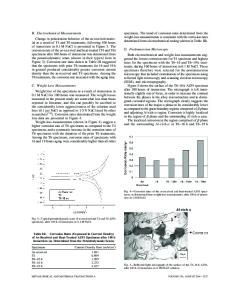Magnesium alloys and graphite wastes encapsulated in cementitious materials: reduction of galvanic corrosion using alkal
- PDF / 393,267 Bytes
- 7 Pages / 432 x 648 pts Page_size
- 84 Downloads / 391 Views
Magnesium alloys and graphite wastes encapsulated in cementitious materials: reduction of galvanic corrosion using alkali hydroxide activated blast furnace slag D. Chartier 1*, B. Muzeau2, L. Stefan3, J. Sanchez-Canet1, C. Monguillon2 1 Commissariat à l'Energie Atomique et aux Energies Alternatives, CEA, DEN, MAR, DTCD, SPDE, F-30207 Bagnols-sur-Cèze, France 2 Commissariat à l'Energie Atomique et aux Energies Alternatives, CEA, DEN, DANS, DPC, SECR, LECBA, F-91191, Gif-sur-Yvette, France 3 AREVA NC / D&S (France) / Technical Department, 1 place Jean Millier 92084 Paris La Défense, France ABSTRACT Magnesium alloys (Mg-0.5%Zr and Mg-1.2%Mn) and graphite from spent nuclear fuel that has been used in the former French gas cooled reactors, have been stored together in AREVA La Hague plant. The recovery and packaging of these wastes is currently studied and several solutions are under consideration. One of the developed solutions would be to mix these wastes in a grout composed of industrially available cement, e.g. OPC, OPC blended with blast furnace slag or aluminous cement. Within the alkaline pore solution of these matrixes, magnesium alloys are imperfectly protected by a layer of magnesium hydroxide (Mg(OH)2, Brucite) resulting in a slow process of corrosion releasing hydrogen. As the production of this gas must be considered for the storage safety, and the quality of wasteform, it is important to select a cement matrix capable of lowering the corrosion kinetics of magnesium alloys. This is especially true when magnesium alloys are conditioned together with graphite wastes. Indeed, galvanic coupling phenomena may increase early age corrosion of the mixed wastes, as magnesium and graphite will be found in electrical contact in the same electrolyte. Many types of cements have been tested and most of them have caused strong hydrogen production when magnesium alloys and graphite are conditioned together into such cement pastes. Exceptions are geopolymer binder which is already known for that and another binder based on alkali hydroxide activated ground granulated blast furnace slag (AHABFS) which is presented in the present article. First are presented hydrogen production experiments that demonstrate the efficiency of AHABFS towards reduction of corrosion of Mg alloys embedded. In a second part, a formulation of fluid mortar based on this binder is proposed. INTRODUCTION The reprocessing of spent fuel of French graphite moderated gas cooled reactors has produced specific wastes. Indeed, fuel assemblies received in La Hague plant for reprocessing comprised a graphite tube containing a metallic uranium rod cladded by a magnesium alloy [1]. Before reprocessing metallic uranium, assemblies had to be dismembered and thus graphite and magnesium alloys wastes have been produced. As there was no conditioning solution for such wastes at this time, wastes were stored together in silos in La Hague plant from 1966 to 1986, waiting for recovery. Nowadays, the recovery and packaging of these wastes is under consideration and one of th
Data Loading...











